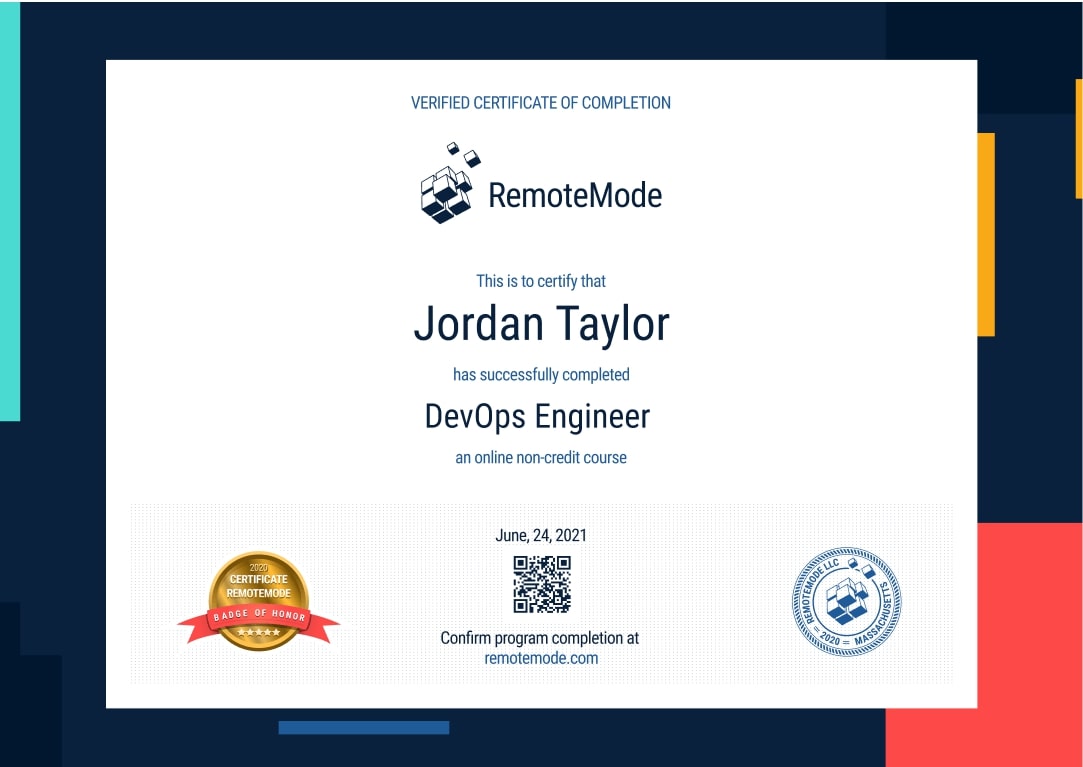Become a DevOps Engineer
Combine traditional IT with its servers, connections, fiber optic, etc., and modern technology like cloud, mobile apps, and iPhones. Launch the software and close the gap between software development and operations. Today DevOps is the newest and up-to-date direction in the IT labor market.
- 4 month
- 123 lessons
- 5 hours per week
- 86 hours



DevOps Engineer Mission Forecast
Landing Zone
With the expansion of the IT sphere, the demand for the DevOps of Engineers is steadily increasing. Lots of new platforms, services and tools are entering the market, and companies are headhunting the specialists who can organize and support these processes. Some biggest and world-known companies like IBM, Microsoft, and Cisco open more than 43,000 positions for DevOps Engineers. The demand is going to show a 24% increase by 2026.
Mission Objective (Who’s Hiring Right Now)
DevOps Engineer Overview
The implementation of the DevOps model for management and software development is expanding and shows stable growth during the last 5 years. Industry leaders all over the world, from NASA to Target, and Hertz to Netflix hire DevOps Engineers to run their systems.
- + 4 Month Courses
- + 5 Hours/Week Self-study
- + 123 On-demand Lessons
- + 86 Hours of training materials
- + Certificate
- + Practise on Topical Real-life Project
- Integrate siloed pieces of software engineering.
- Write script codes to customize and patch software.
- Control the work of software applications.
- Upgrade the security system for end-users of the software.
- Link code, databases, and software to function effectively.
- Keep documents of digital software projects.
Be ready for Liftoff
Docker for DevOps
By taking this course, one is guaranteed to learn about Docker, and other integral variables such Dockerfiles, Docker Machine, Docker Kinematic, and Docker Registry. More importantly, this tutorial aims to help aspiring developers create their very first application.
Get Started with Docker
The introductory part composed of four sub-topics holds discussions about Docker, thoroughly tapping its uses, installation process, and advantages. In this tutorial, course takers are expected to understand the fundamentals of the platform including crucial execution process, implementation of sublime texts, utilization of Docker registry, and its lasting relevance to other operating systems. More importantly, this section enumerates the prerequisites of the production/ programming phase including a list of workable systems and programming languages.
First Docker Application
This five-part lesson then deals with the actual development process. It runs course takers through a series of tutorials, which aim to teach about the Dockerfile, set a project directory, compose a Docker prototype, and finally, develop a unique and error-free application. Other crucial factors that are presented in this section are alternative key development processes, the concept of project scaffolding, Github best practices, working directory, and Flask implementation.
Staging Server
The primary focus of this section is Server Staging, which will be put not only in the context of Docker but also in Sudo. The process carries several advantages, and those are comprehensively outlined before proceeding to the more complex part of the lesson. Not only does it focus on the theories, it also allows for an examination of operating systems so that course takers will be familiar with what is the most viable. Other technical know-hows presented are:
- Provisioning the stage server
- Placing Docker images
- Pushing web application
- Securing the staged server
- Creating static IP address
- Creating SSH
Systemd
This part then tackles the concept of systemd, with focus on unit creation, assessment, and deployment. Divided into three sub-topics, the first lecture introduces the principles of units, their definition, function, and advantages. More so, it allows course takers to create their very first unit files while learning how to deploy them best. The second part then focuses on systemd, and its connection with the development of self-signed SSL certificates and official nginx image. Finally, the last part discusses methods on how to properly deploy files while also presenting the concept of Nginx.
Production Server Creation
Production servers were then put under study, in which course takers are expected to understand the process of creating and preparing droplet, configuring a domain, planning of scales, and remote logging. Composed of eight guides, a comprehensive learning is geared towards the execution of the following:
- Determining a hosting provider
- Logging on Digital Ocean
- Identifying Domain Registrar
- Evaluating encryption codes
- Incorporating certificates
- Verifying certificates
- Integrating additional services
- Configuring management tools s
- Monitoring metrics and alerting
Backups and Upgrades
Included in the final lesson are the practices after establishing an application. This involves utilization of Docker without the help of graphic user interface, creating automated backups and upgrades, and lastly, upgrading the Docker platform. It then aims to see proper demonstration of other crucial commands such as replacing debian with coreos, setting up automated functions, and upgrading the current version of Docker to larger and more optimized versions.

Mission Control
- Study on course with mentor support
- Take part in Virtual Lab projects to upgrade your portfolio
- See your results in the Dashboard and win the competitions with others students
- Control the progress of study using Activity Tracking Log
- Take a step closer to your job of dream with interview prep and upgrading SV
In partnership with
Set your trajectory (123 video 40 hours)
Certificate of Completion
- Certification recognized by industry companies
- Real project from virtual labs
- The program built on 100% self-study
- Course videos and subtitles
- Practical quizzes
- Mentored by high-class specialists

Grow into a DevOps Engineer
Combine traditional IT with its servers, connections, fiber optic, etc., and modern technology like cloud, mobile apps, and iPhones. Launch the software and close the gap between software development and operations. Today DevOps is the newest and up-to-date direction in the IT labor market.
Learning program
- 4 months duration, 5 hours per week
- 123 lessons, 86 hours
- 100 % flexible timetable
Virtual lab
- Real projects
- GitHub portfolio
- Experts feedback
Career Services
- Interview prep
- SV writing
- Filling LinkedIn profile
Request More Information
View pricing and financing options